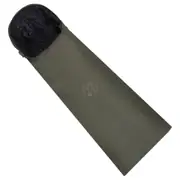How to Clean and Store a Sleeping Bag?
November 21, 2025 at 12:25 PMWhy Is Sleeping Bag Cleaning Important?
Sleeping bags are one of the essential pieces of equipment that preserve body heat. Whether used in the field, inside a tent, or at high altitudes, they are constantly exposed to moisture, dust, sweat, and natural body oils. Over time, these contaminants weaken the insulation layer and reduce the bag’s thermal efficiency. The thin film of dirt that accumulates on the surface also limits breathability and causes the insulation to collapse.
Condensation inside the tent, body sweat, and nighttime humidity can accumulate within the insulation fibers and increase bacterial growth. This leads to unpleasant odors and weakens the inner lining. Proper cleaning is critical for maintaining performance in all sleeping bags, whether synthetic-filled or constructed with advanced insulation blends.
Featuring a windproof, water-repellent, and highly tear-resistant Nylon Water Repellent outer and inner shell, the Mumya –32 Sleeping Bag delivers reliable insulation thanks to its Micro Denier Nano Soft synthetic fill. This fill is not down, but it mimics down-like loft while maintaining insulation even when wet. Similarly, synthetic-filled models such as the Kepenek –24°C are moisture-tolerant, but incorrect washing practices can still weaken fiber elasticity.
In short, cleaning a sleeping bag is not only about hygiene — it is essential for maintaining the equipment’s safety and long-term performance.

Why Clean Your Sleeping Bag Before Use?
Sleeping bags used in harsh outdoor environments inevitably accumulate dirt, moisture, and dust. Proper cleaning and maintenance are critical for preserving insulation performance.
Things to Know Before Cleaning a Sleeping Bag
Before washing a sleeping bag, a few details should be checked. Proper preparation protects the insulation and prevents unnecessary wear.
The insulation type determines the cleaning method:
- Down fill is more delicate and prone to clumping.
- Synthetic fill tolerates moisture better but loses loft if washed incorrectly.
- Micro Denier Nano Soft insulation (like in Mumya –32) is durable but still requires gentle, low-pressure washing.
Outer shell fabrics, typically technical nylon or ripstop blends, have water-repellent coatings. High heat or harsh chemicals shorten their lifespan.
Only wash when necessary. Excessive or improper washing damages both insulation fibers and water-repellent coatings.
If the bag has been stored for a long time, mild odors are usually caused by trapped moisture and can often be removed by proper ventilation. Signs of mildew, however, require deeper cleaning.
How to Wash a Sleeping Bag (Step by Step)
1. Identify the Insulation Type
- Down bags: Hand-washing only.
- Synthetic bags: Machine-washable on gentle cycle (30°C).
- Nano Soft fill: Gentle, low-pressure wash.
2. Close All Zippers and Velcro
Prevents snagging and protects the shell’s water-repellent coating.
3. Use the Right Detergent (No Fabric Softener!)
- Regular detergents coat fibers and reduce insulation.
- Use detergents designed for technical fabrics.
- Fabric softener damages both fill and water-repellent coatings.
4. Choose Hand Wash or Machine Wash
- Down bags → Hand wash
- Synthetic bags → Gentle machine wash
Mumya –32: best washed by hand; if machine-washed, only on a gentle, low-spin cycle. Kepenek –24°C: safe for gentle machine wash.
5. Set Correct Water Temperature
- The ideal temperature is 30°C.
- Higher temperatures damage coatings and insulation fibers.
6. Rinse Thoroughly
Repeat until water runs clear. Detergent residue causes odor and fiber clumping.
7. Proper Drying
Drying is critical:
- Never wring or twist the bag.
- Down bags: Very low heat, long drying time.
- Synthetic bags: Faster drying, but still avoid high heat.
- Use dryer balls to restore loft.
8. Redistribute the Fill
After drying, gently fluff the bag and ensure even distribution of insulation.
Sleeping Bag Cleaning Methods
Hand Washing
Safest method for protecting insulation. Use lukewarm water and gentle agitation. Mumya –32 performs best with hand washing.
Machine Washing
Only for synthetic-fill bags. Use a front-loading machine, gentle cycle, low spin. Kepenek –24°C fits this method; Mumya –32 should be washed alone.
How to Dry a Sleeping Bag
Drying mistakes are the most common cause of insulation damage.
- Never twist or wring the bag.
- Use low heat if using a dryer.
- Add dryer balls to prevent clumping.
- Air-dry in the shade if outdoors.
- Never store the bag before it is fully dry.
How to Remove Sleeping Bag Odor
Most odor comes from moisture and improper storage.
- Fully dry and ventilate the bag in a shaded area.
- Sprinkle a light layer of baking soda inside, then shake out.
- Use antibacterial sprays sparingly to avoid damaging the lining.
- High-loft bags like Mumya –32 may need longer ventilation.
Sleeping Bag Storage Tips
Proper storage is as important as proper cleaning.
- Ensure the bag is 100% dry.
- Avoid long-term storage in a compression sack.
- Use a large, breathable storage bag.
- Store in a cool, dry, dark place.
- Air the bag every few months.
The waterproof stuff sack of the Mumya –32 is excellent for transport — not for long-term storage.
Sleeping Bag FAQs
Can a sleeping bag be washed in a washing machine?
Yes, for synthetic fill — on gentle cycle, low heat. Down bags should be hand-washed.
What temperature should I wash my sleeping bag at?
30°C is ideal.
How to wash a down sleeping bag?
By hand, using down-specific detergent. No wringing.
How to clean a synthetic sleeping bag?
Gentle machine wash, no softener.
Why does a sleeping bag lose loft after washing?
Wet fibers collapse; loft returns as the bag dries.
Does fabric softener damage a sleeping bag?
Yes. It coats fibers, reduces insulation, and ruins water-repellent coatings.
Can a sleeping bag be hand washed?
Absolutely — it is the safest method for high-performance models.
Can you use a dryer?
Yes, on low heat. Even synthetic bags should avoid high temperatures.

